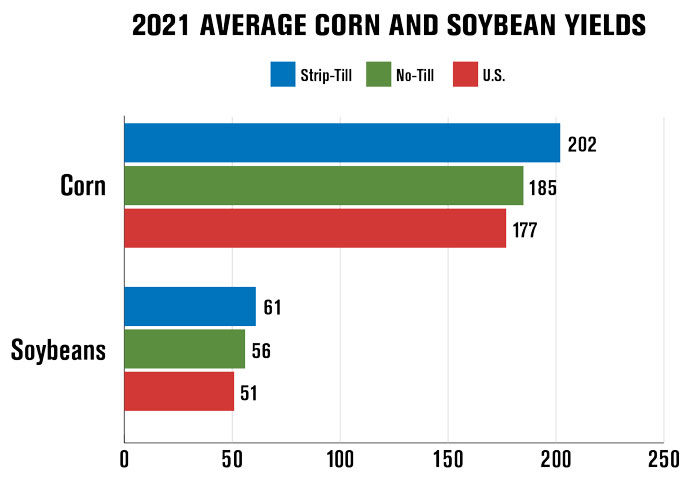No-Till Farmer
Get full access NOW to the most comprehensive, powerful and easy-to-use online resource for no-tillage practices. Just one good idea will pay for your subscription hundreds of times over.

HIGHER YIELDS. In 2021, the average strip-tiller’s yields outperformed U.S. averages. Strip-tillers who responded to the 2022 survey reported average corn yields of 202 bushels and average soybean yields of 61 bushels per acre. No-till corn averaged 185 bushels per acre, while no-till soybeans averaged 56 bushels per acre.
Sources: Strip-till yield information from 2022 Strip-Till Opertational Benchmark Study. No-till yield information from 2022 No-Till Operational Benchmark Study. U.S. averages from USDA’s National Agricultural Statistics Service.
Although the 2021 planting season started well, wet areas in the south, hail and frost in the Midwest, and high heat and drought in the west and Great Plains proved challenging for farmers last year
Despite the regional weather events, the average strip-tiller’s yields outperformed the U.S. average and their no-till counterparts, according to data from the 2022 Strip-Till Operational Practices Benchmark Survey.
Most of this year’s respondents farm in the U.S. About 63% farm in the Corn Belt, followed by about 21% in the Plains/West. More than 93% of them both strip-till and no-till.
More than half of the respondents have been strip-tilling for 10 years or less (55%). They strip-till an average of 1,083 acres of corn and 548 acres of soybeans. Both numbers represent a significant increase in acres compared to 2020 — 58% more corn and 79% more soybeans — but this increase can be partially attributed to more resondents running large-acre operations (more than 5,000 acres) this year. Farmers with 5,000 or more acres made up 9.6% of respondents, compared to 4.7% in 2021. About 44% of respondents are farming 1,000 acres or less. Another 28% farm 1,001-2,000 acres.



FAVORING FALL. Most strip-tillers who responded to the 2022 strip-till benchmark study make at least some strips in the fall. About 41% do fall strip-till, 29% do spring strip-till and 29% do both. More farmers opted to strip-till in both the spring and fall — rather than just the spring — compared to 2020.